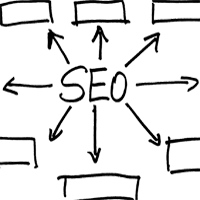On-Site SEO Audits

 Search engine optimization isn't what it used to be. Once the dominion of the marketing department and a few technical staffers, SEO now requires full participation from nearly every corner of the enterprise - from customer support personnel to social media teams, all the way up to the C-Suite.
Search engine optimization isn't what it used to be. Once the dominion of the marketing department and a few technical staffers, SEO now requires full participation from nearly every corner of the enterprise - from customer support personnel to social media teams, all the way up to the C-Suite.
But few chief executives or their fellow chiefs in tech, marketing, operations or finance may understand how a brand's SEO strategy impacts the bottom line and even their own day-to-day tasks. While it is certainly possible for a company to exist with poor SEO practices (search engines rely heavily on brand signals which can cover up many of the most egregious mistakes), having the C-Suite audit a corporate website can prove helpful. And aligning current SEO best practices with business objectives will reveal that a thriving online presence is all but guaranteed - even for the most competitive industries.
The objective of an on-site SEO audit by the C-Suite is to indirectly identify points of interest from a corporate perspective that may be impacting effectiveness and efficiency down the corporate hierarchy, ultimately leading to poor performance as it relates to search engine visibility. Points of consideration should address accessibility and structure, relevance and targeting, and quality of both content and design.
Conversion funnels, the paths established to direct users to an action (e.g. registration, purchase, download), should be the primary focus of the audit of site accessibility and structure. The aim in this phase is to remove the barriers that prevent search engines and users from accessing content and ultimately completing the developed conversion task.
The procedure to determine if a site is "accessible" and its structure conducive to completing tasks such as registration, starts by examining something as basic as whether the links to individual pages are active or if they result in a 404 error.
Search engine optimization software provider WebCEO conducted an SEO audit of the websites of Fortune 100 companies and found that, on average, every second index page had a broken link. Within two website levels, the average number of broken links was 30 per company. If search engines and users are unable to find content on a website, the site has little chance of being indexed in the search return lists. Using SEO software solutions, or at least requesting reports on key SEO factors such as broken links, will hold specific teams and divisions accountable and ensure that users will continue to flow through conversion funnels and won't negatively impact the brand or bottom line.
Keyword Relevance & Targeting
While it is obviously important to make sure that visitors can access the website and find its content by ensuring, for example, that there are no broken links, the C-Suite and its teams of executives also need to analyze and audit what is found when visitors do arrive. The focus, therefore, should be on keywords and phrases - the virtual blood that courses through the veins of the Internet.
What needs to be answered in an audit of keyword relevance and targeting is how the pages being optimized accommodate the search terms and phrases in use by prospective visitors and how they relate to an organization's specific objectives. For the most part, keywords can be separated into three distinct types - navigational, informational and transactional.
Navigational queries tend to be brand specific (e.g. "Facebook login" or "Fedex package tracking"). It is highly likely for most companies that some percentage of their traffic will originate from these query types. Informational and transactional queries, however, are what drive new business and sales and should be what are audited and monitored most aggressively.
Informational queries are those which aim to uncover specific information. Keyword modifiers such as "tips", "how-to", and "list" are just some examples. These query types lead consumers deeper into the site and support both awareness and a sense of trustworthiness. If it is information that your website visitors want, it is information they shall have - so answer their questions and you'll earn some friends and customers along the way. One valuable resource to understand the types of questions site visitors ask through search engines is WordTracker's Keyword Questions feature (https://wsm.co/q1vFid).
The SEO-aware C-Suite also needs to analyze whether the keyword choices on landing pages are helping fulfill the ultimate aim - transactions and conversion. Understanding which terms and phrases have commercial intent can make the difference between high and low visibility on the search results pages, as well as determining a Web property's ability to generate revenue. It is difficult to identify which keywords have the most commercial intent, but visitors typically tend to use "long tail" keyword phrases to help fulfill their immediate needs.
Content & Design Quality
An interesting research study was released by About.com in September 2011, revealing that users searching on the Internet exhibit three distinct human behavior search patterns: "Answer Me", "Educate Me" and "Inspire Me". People in an "Answer Me" moment (46 percent of all searches) want exactly what they ask for, delivered in a way that allows them to get to it as directly as possible. Marketers should feature product benefits front and center and align content in a way that presents quick, easyto- find answers. For the "Educate Me" search mindset (26 percent of all searches), marketers should aim to create messaging that is informative and provide ways for users to learn more about topics from multiple angles, aligning content that presents in-depth information and resources. Finally, for the "Inspire Me" search mindset (28 percent of all searches), marketers should develop content that inspires creativity and offers endless choices. These users have an open mind and want to be led, so expect them to consume content in multiple formats.
People's behaviors, needs and preferences in the offline world drive their behaviors and preferences online. Understanding how human behavior affects patterns in search behaviors can help marketers know and connect with the people who use their products. The right formula for your brand is critical to reaching your consumers in a relevant way.
Search engine optimization in the enterprise requires more oversight from the C-Suite. Auditing the general accessibility of a website, the relevance of keywords to the landing pages and the quality of both content and design is fundamental to today's enterprises looking to capitalize on search engine traffic.









